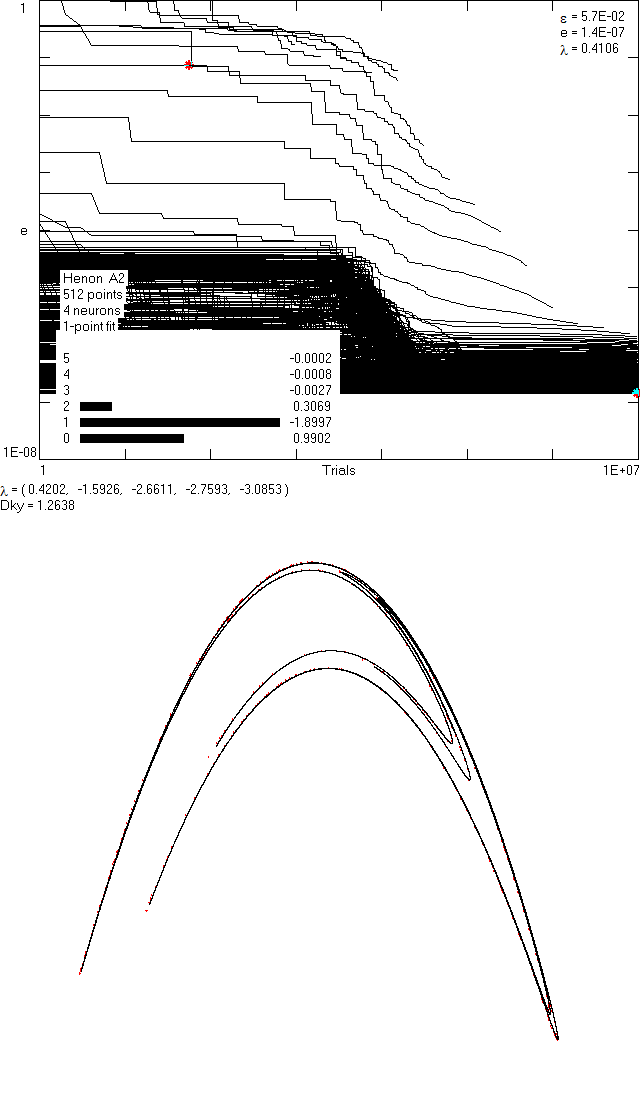LagSpace 1.3
 LagSpace Output
LagSpace Output LagSpace
is a Windows program written in PowerBASIC used in scalar
time series analysis. Its primary use is in calculating the lag
space (a generalization of the optimal embedding space) and
Lyapunov
exponent spectrum for a given time series. For a more
thorough explanation of the uses of this program, please consult
our published papers: 1) Neural
Network Method for Determining Embedding Dimension of a Time
Series and 2) Evaluating
Lyapunov Exponent Spectra with Neural Networks.
Installation
and Use
- Download LagSpace.exe
and the test
time series taken from the Henon map
- Run LagSpace and input the file name of the test time series
(e.g. henon.dat)
- Enter the number of neurons n (typical value: 6)
- Enter the embedding dimension d for the neural
network (typical value: 5)
- Enter the exponent e of the error function:
(predicted point - actual point)e (typical
value: 2 for least squares)
- Enter the number of steps ahead the neural network should
calculate to determine the error (typical value: 1, larger
values will slow the calculation)
- Enter your choice of activation function for the neurons
(typical value: hyperbolic tangent)
- Run until you decide to manually stop the program (press ESC
to stop the program or any other key to change the neural
network options)
Important
Notes
- To see a list of commands that are active while the program is
running, press the space bar
- LagSpace will overwrite any .txt, .bmp, .net
and .wav file that shares the same name as the time series input
in LagSpace within the same directory
- A constant term Ai0
and an output weight Bi
are always included for each neuron which is why there are d+2 parameters for each
neuron
- Be patient! Neural networks have many parameters, and the
training schedule we employ is computationally intensive
- The PowerBASIC source code is also downloadable here
- Version information is available here
Output
- .txt file: The history of the neural network training
- 1st line: Date/Time of Neural Network output
- 2nd line: Number of Neurons, Embedding Dimension, Letter
of Activation Function, Exponent on Error Function, Number
of steps ahead that neural network calculated error, Error
- 3rd - (N - d)th
line: Neural Network parameters arranged Ai0
- Aid
then Bi
for the i-th
neuron where A's are connection strengths between
neurons and B's scale the output of the activation
function
- (N-d)th - Nth
line: Sensitivity output for each dimension of the Neural
Network
- This pattern repeats for each neural network saved
- .bmp file: The visual representation of the graph saved at the
time it was last drawn
- To the right, you will see a sample output
- The top graph shows training progress
- In the top-right corner: epsilon is the size of the
neighborhood
- In the top-right corner: e is the size of the error
- In the top-right corner: lambda is the largest Lyapunov
exponent
- On the middle-left side: Basic neural network and
time-series information are shown
- On the middle-left side: The sensitivities to each input
dimension and their values are shown
- On the middle-left side: lambda is the spectrum of
Lyapunov exponents
- On the middle-left side: DKY is the Kaplan-Yorke
dimension
- The bottom graph shows the strange attractor of the data
plotted Xn to Xn-1
- .net file: The next 100,000 points forecasted from the neural
network
- .wav file: A sonification of the attractor produced by
iterating the neural network for 100,000 steps
Disclaimer:
This program is freeware. If you decide to use it, you do so
entirely AT YOUR OWN RISK. The authors do not provide support but
are always interested in your comments and suggestions.

